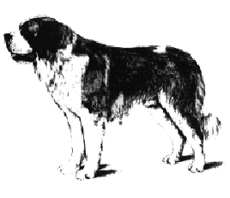St Bernard
General Information - St Bernard

Group:
utility
Size:
extra large
Lifespan:
8-10 years
Exercise:
low
Grooming:
low
Trainability:
medium
Watchdog ability:
low
Protection ability:
very low
Area of Origin:
Switzerland
Date of Origin:
Middle Ages
Other Names:
St. Bernhardshund,
Alpine Mastiff
Original Function:
Draft, search and
rescue







